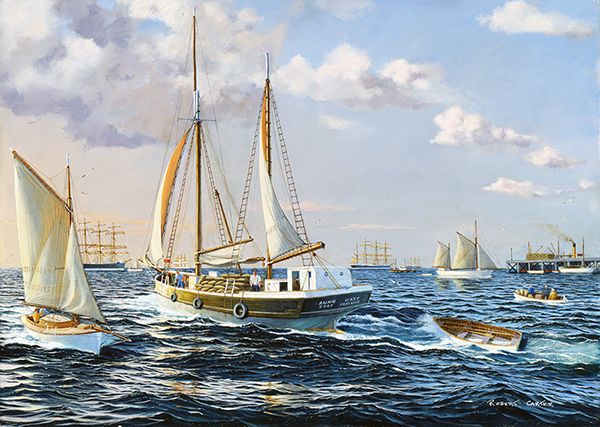"Annie Watt – Port Victoria, 1930s" by Robert Carter
From time to time we have showcased the remarkable marine paintings of Robert Carter OAM, FASMA, FISMP, joint founder of the Australian Society of Marine Artists with Dean Claflin.1 You can read more about Bob's biographical information by clicking here.
Robert is one of Australia's leading marine artists and he has kindly given permission for the AnArt4Life blog to run a series on his marvellous paintings of the sailing ship era recently published in The Marine Paintings of Robert Carter .
In this publication Bob has presented his paintings in five parts and we will follow this same format. We will launch the AnArt4Life Robert Carter Marine Series with Annie Watt- Port Victoria, 1930s from Part One: Maritime Australia.

The tiny grain ports in Spencer Gulf, South Australia, played host to the world’s remaining windjammers when millions of acres of cereal crops were harvested in the surrounding countryside every summer.
Twenty large sailing ships loaded grain in the Gulf in 1933. Most of these sailing ships were from the Finnish Ship owner Gustaf Erikson’s fleet but the last of the German Laeisz fleet, Padua & Priwall, Vinnen’s Magdalene Vinnen also loaded along with Favell, Finland, Abraham Rydberg and CB Pedersen from Sweden.
From December to March these sailing ships would sail in from the Great Australian Bight after travelling from their home ports in Europe, usually calling at Port Lincoln on the western shore for their orders. Some would remain in Port Lincoln to load and others were sent off to other ports in the gulf – Port Broughton, Port Germein, Port Augusta, Port Pirie, Port Rickaby, Wallaroo and Port Victoria. As there was an open roadstead, tugs were not required. They all had long jetties, the one at Port Germein being a mile long.
At Port Victoria the water was not deep enough for large sailing ships to go alongside so the bagged grain was taken out to the sailing ship anchored offshore in ketches. These were small sailing craft that carried produce and other cargoes around the Gulf in the years before road transport resulted in their demise. They were not all ketch rigged; some two- and three-masted schooners were used but still referred to as ‘ketches’. In earlier years they sailed out to the waiting sailers at anchor but all had auxiliary engines in the latter years.
The ketch portrayed here is Annie Watt, which has been restored. It was customary to tow the dinghy astern as bagged grain was also loaded on top of the hatch where the boat was normally kept. The last sailing ships to load at Port Victoria were the four-masted barques Pamir and Passat in 1949.2
The paintings in Part One of Marine Paintings of Robert Carter refer to vessels that were employed in the Tasman Sea trade with New Zealand, together with those that were regular carriers for Australia's overseas exports of wool, grain and coal - in particular from the ports of Newcastle, New South Wales and Sydney (Port Jackson). The South Australian grain trade is covered in Part Three of the book.3
© Thank you to Robert Carter who kindly gave permission for the image of his work to be shared on AnArt4Life.
Please check out the Robert Carter Website.
And also the site for the Marine Artisits Australia.
And I must also welcome our latest subscriber to the AnArt4Life blog Rut in Arizona who I think is our first subscriber from this state of the USA. Welcome aboard.
The next glorious vessel in our Robert Carter Marine Series will appear in about a week. Tomorrow Julie will take you into the world of embroidery. And have a great weekend everyone.
Credits
1. Correspondence with Robert Carter
2. robertcarter.com.au
3. The Marine Paintings of Robert Carter OAM, FASMA, FISMP, Published in Australia by Robert Carter Maritime, Gosforth NSW, 2320, Australia, 2022
